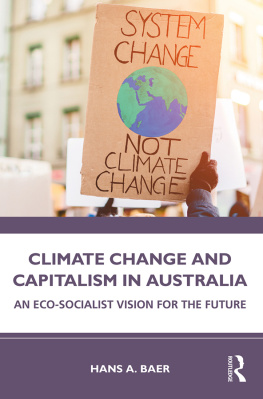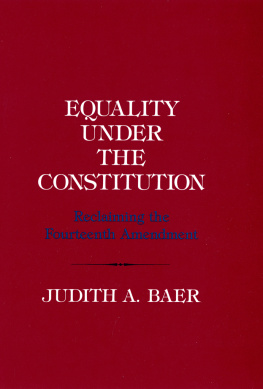First published 2020
by Routledge
2 Park Square, Milton Park, Abingdon, Oxon OX14 4RN
and by Routledge
52 Vanderbilt Avenue, New York, NY 10017
Routledge is an imprint of the Taylor & Francis Group, an informa business
2020 Hans A. Baer
The right of Hans A. Baer to be identified as author of this work has been asserted by him in accordance with sections 77 and 78 of the Copyright, Designs and Patents Act 1988.
All rights reserved. No part of this book may be reprinted or reproduced or utilised in any form or by any electronic, mechanical, or other means, now known or hereafter invented, including photocopying and recording, or in any information storage or retrieval system, without permission in writing from the publishers.
Trademark notice: Product or corporate names may be trademarks or registered trademarks, and are used only for identification and explanation without intent to infringe.
British Library Cataloguing-in-Publication Data
A catalogue record for this book is available from the British Library
Library of Congress Cataloging-in-Publication Data
A catalog record has been requested for this book
ISBN: 978-0-367-19265-5 (hbk)
ISBN: 978-0-367-18605-0 (pbk)
ISBN: 978-0-429-20148-6 (ebk)
Although not quite as ubiquitous as automobiles, airplanes of many sorts (commercial, military, and private), have become an integral component of modern life. Air travel or aeromobility has become a dimension of many peoples lives, particularly in developed societies but increasingly in developing societies, and a perceived necessary part of many peoples work and status requirements. Around the 1950s or so, airplanes began to displace shipping or railroad companies as the symbols of international mobility (Sampson 1984:108). Furthermore, automobiles, along with buses, had already come to increasingly displace trains, both long-distance ones and local ones, particularly in developed capitalist countries and later in developing societies. Airplanes have been the impetus for the development of huge airport complexes, most of which continue to expand to meet the growing demand for flights. Passenger air travel is increasing at a rate of about 5 percent per annum and is projected to triple by 2030. The aviation industries, in terms of aircraft production and maintenance, airline companies, and military aircraft utilization, have become pivotal components of the capitalist world system.
Grappling with airplanes as a growing source of greenhouse gas emissions is part and parcel of a larger project of creating a more socially just and environmentally sustainable world system, one characterized by a safe climate. As humanity enters an era of increasingly dangerous climate change accompanied by tumultuous environmental and social consequences, it must consider alternatives that hopefully will circumvent the dystopian scenarios that ongoing socioeconomic, ecological, and climate crises will face humanity if business continues as usual. Shifting to a more sustainable transport system, which would entail far fewer private motor vehicles and far less reliance upon air transportation, will continue to be a vexed challenge, even in the best of all worlds.
Humans from ancient times have dreamed of flying like the birds they observed and even hunted for their sustenance. The Italian artist-inventor Leonardo da Vinci (14521519) created designs of flying machines that were well ahead of his time. The airplane and related flying machines, such as helicopters and gliders, are technological devices or machines that evoke excitement, aspiration, adventure, fear, and ambivalence. Although they are not as ubiquitous as automobiles, airplanes of many sorts (commercial, military, and private), have become an integral component of modern cultural and social life. Jeremy R. Kinney (2006: xiii) maintains that the airplanes use as an instrument of commerce, as a weapon of war, and as a vehicle for recreation reflects its adaptation to the modern world by humankind.
As Adey (2010:208) so astutely observes, the airplane has promised a lot, an awful lot, and has a lot to answer for. In a similar vein, Urry (2009a:33) argues that international air traffic has created a wide array of mobilities, including [h]oliday-making, money laundering, business travel, drug trade, infections, international crime, food transport, asylum seeking, leisure travel, arms trading, people smuggling, and slave trading. These mobilities have become an accepted, and apparently necessary, part of many peoples work and status requirements.
Some commentators wax eloquently about the positive dimensions of aeromobility. Saulo Cwerner (2009:45) maintains that aeromobility:
- Has been a key force in shrinking the world by enabling social relations and networks to be maintained over longer distances and at greater regularity and pace.
- Has facilitated the maintenance of social networks and connections over long distances, such as in the case of immigrants and their home countries.
- Has altered the nature of contemporary work and provided for new business opportunities, particularly over long distances.
He does acknowledge that aeromobilities may reinforce social inequalities, noting that even the vast majority of low-cost flights are taken by relatively affluent people, even though they supposedly have democratized air travel.
While a growing number of critical scholars (Baer 2012; Foster 2009; Klein 2014) acknowledge global capitalism constitutes the overarching driver of anthropogenic climate change, one of the smaller elephants in the room is the growing number of airplane flights worldwide. Airplanes have been the impetus for the development of huge airport complexes, most of which continue to expand to meet the growing demand for flights. Passenger air travel is increasing at a rate of about 5 percent per annum and is projected to triple by 2030 (Brazier 2014:35). An OECD (2012:4) report states:
Aviation plays an essential role in global economic development by connecting people for business and tourism, supporting the trade of goods, defence, and a range of political and humanitarian concerns. Global commerce and employment are significantly dependent on the aviation sector. In 2007, according to the World Economic Forum (WEF), the aviation industry contributed USD 426 billion to global GDP directly, an additional USD 490 billion indirectly, and another USD 620 billion through facilitating global tourism. In sum, the total contribution is equal to 3.2% of global GDP. For 2007, the aviation industry accounted for 33 million jobs.











